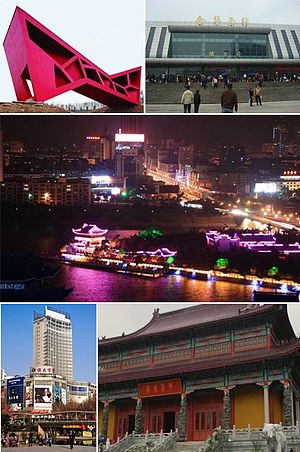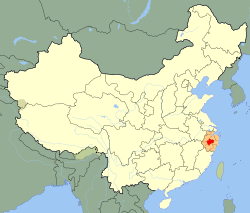- Jinhua
-
For other uses, see Jinhua (disambiguation)."Chin-hua" redirects here. It is not to be confused with Chinua.
Jinhua
金华— Prefecture-level city — 金华市 Clockwise from top: Bridging Tea House, Jinhua Railway Station, Jinhua City 1, Jinhua City 2, Dabeilou Temple Jinhua (red) in Zhejiang province (orange) and China Coordinates: 29°05′N 119°39′E / 29.083°N 119.65°E Country People's Republic of China Province Zhejiang County-level divisions 9 Township-level divisions 191 Government – CPC Secretary – Mayor Chen Kunzhong(陈昆忠) Area – Prefecture-level city 10,916 km2 (4,214.7 sq mi) – Urban 2,021 km2 (780.3 sq mi) – Metro 2,021 km2 (780.3 sq mi) Population (2010 census) – Prefecture-level city 4,614,100 – Density 422.7/km2 (1,094.8/sq mi) – Urban 1,082,974 – Urban density 535.9/km2 (1,387.9/sq mi) – Metro 1,082,974 – Metro density 535.9/km2 (1,387.9/sq mi) Time zone China Standard (UTC+8) Area code(s) 579 GDP ¥168.2 billion GDP per capita 2008 ¥36,538 License Plate Prefix 浙G City Flower Camellia Jinhua (simplified Chinese: 金华; traditional Chinese: 金華; pinyin: Jīnhuá; Wade–Giles: Chin-hua; lit. "Golden brilliance") is a prefecture-level city in central Zhejiang province of Eastern China. It borders the provincial capital of Hangzhou to the northwest, Quzhou to the southwest, Lishui to the south, Taizhou to the east, and Shaoxing to the northeast.
Its population was 5,361,600 at the 2010 census including 1,092,852 in the built up area. One can notice that the cities of Dongyang and Yiwu are now in the same agglomeration, a built up area of 1,757,157 inhabitants bigger than the one of Jinhua itself.
Jinhua is rich in red soil and forest resources. The longest river Jinhua River (or Wujiang River) flows through Lanjiang River, Fuchunjiang River and Qiangtang River, and reaches the Grand Canal and other coastal ports.
The city is best known in China for its dry-cured Jinhua ham and Subing.
Contents
History and culture
The history of Jinhua goes back to the 2nd century BC, when it was a county subordinate to Shaoxing. It was given the name Jinhua under the Sui dynasty in 598, and later became the seat of a prefecture. The present city and its walls date to the time of the Mongol emperors in 1352.
The most famous native of Jinhua is the Immortal Huang, a Daoist holy man of the 4th century AD, whose descendants still live in the area. Wuyang Shan (Reclining Sheep Mountain) is said to be a sheep which was turned to stone by the Immortal Huang, a trick which he learned through his years of diligently studying Daoism.
Economically Jinhua has always prospered from its position as the regional collecting and processing center for agricultural and forestry products (chiefly rice and bamboo). It is currently the second most important grain producing area in Zhejiang Province. In 1985 Jinhua was promoted to City status, and now is responsible for administering four cities, four counties and a district. Animals raised there include dairy cattle, meat hogs (for the production of Jinhua ham, a famous local product for 900 years) and honeybees. Jinhua's industrial sector has developed more recently, producing machinery, metallurgy, pharmaceuticals, building supplies and electrical and electronic equipment.
The Tang dynasty painter Guan Xiu[1] (Kuan-hsiu) was born in Jinhua. He is known for his paintings of Buddhist holy men.
There are numerous scenic and historical sites in the Jinhua region, including many places associated with the Immortal Huang, and a palace of the Dukes of the Taiping Heavenly Kingdom.
Geography and climate
Jinhua is located at latitudes 28°32-29°41 N and longitudes 119°14’-120°46’ E in the center of the eastern coastal province of Zhejiang. It is connected with the three port cities of Hangzhou, Shanghai in the north and Ningbo in the east. It extends in the west to the vast inland area of the western part of Zhejiang Province and Fujian, Jiangxi and Anhui Province. Because of its geographical position, it has become a major hub of land transportation, a vital communication line connecting the four provinces of Fujian, Zhejiang, Jiangxi and Anhui, and a central city of central and western Zhejiang.
Climate
Jinhua belongs to the subtropical monsoon climate zone and has four distinctive seasons. Spring is warm; summer is hot and dry; autumn is cool and humid; winter is cold and dry. The annual average temperature is about 17.52C (63.52F). The coldest month is January while the hottest is July or August.
Climate data for Jinhua (1971−2000) Month Jan Feb Mar Apr May Jun Jul Aug Sep Oct Nov Dec Year Average high °C (°F) 9.1
(48.4)10.9
(51.6)14.8
(58.6)21.7
(71.1)26.5
(79.7)29.2
(84.6)33.8
(92.8)33.5
(92.3)28.5
(83.3)23.6
(74.5)17.9
(64.2)12.3
(54.1)21.82
(71.27)Average low °C (°F) 2.2
(36.0)3.7
(38.7)7.3
(45.1)13.3
(55.9)18.2
(64.8)21.9
(71.4)25.3
(77.5)24.9
(76.8)20.8
(69.4)15.3
(59.5)9.4
(48.9)3.8
(38.8)13.84
(56.92)Precipitation mm (inches) 71.5
(2.815)91.6
(3.606)160.1
(6.303)168.9
(6.65)186.6
(7.346)258.5
(10.177)129.5
(5.098)109.1
(4.295)103.1
(4.059)68.9
(2.713)55.9
(2.201)47.9
(1.886)1,451.6
(57.15)Avg. precipitation days (≥ 0.1 mm) 13.4 14.5 18 17.1 16.1 16.5 12.4 11.9 11.2 9.6 8.2 8.6 157.5 Source: Weather China Administrative divisions
The prefecture-level city of Jinhua administers 9 county-level divisions, including 2 districts, 4 county-level cities and 3 counties.
- Wucheng District (婺城区)
- Jindong District (金东区)
- Lanxi City (兰溪市)
- Yiwu City (义乌市)
- Dongyang City (东阳市)
- Yongkang City (永康市)
- Wuyi County (武义县)
- Pujiang County (浦江县)
- Pan'an County (磐安县)
These are further divided into 191 township-level divisions, including 107 towns, 73 townships and 11 subdistricts.
Economy
Jinhua has a rather flexible economic system with distinctive economic characteristics in different areas. Its economic structure is largely dependent on private sector activity. 90% of enterprises are in the private sector. Up to 88% of its GDP comes from the private sector.
Industry
Jinhua enjoys an advanced civilian-owned economy, with its industry mainly supported by processing and manufacturing. Leading industries of the City include clothing and textile, mechanics and electronics, pharmacy and chemistry, manufacturing crafts, metalwork processing architecture and building materials, automobile-and-motorcycle accessories, food processing, plastic ware, etc.
Industries are distributed with different characteristics in different counties or county-level cities. For instance, Yiwu is characterized by its light-industry commodities, Yongkang by its automobile-and-motorcycle accessories and mechanical and electric tools, Dongyang by its clothing, architecture and magnetic materials, the City Proper by its pharmacy, construction materials and industrial measures, Lanxi by its non-ferrous metal, cement, towels and daily chemicals, and Pujiang by its textile, lockmaking, and lantern ornaments of crystals, etc.
Handicraft
Traditional handicrafts have been flourishing in Jinhua. The wood carving and bamboo weaving in Dongyang, the straw plaiting, lace purling and crystals carving in Pujiang, and the hardware crafts in Yongkang, all enjoy a long history of development and the products sell well both abroad and at home.
Transportation
Jinhua city is approximately three hours by car from Shanghai. There is also the D-train which will take approximately 2.5 hours, or about four hours by ordinary train.
Jinhua enjoys convenient transportation, being the communications center in Southeast China between coastal and inland areas, and one of the major hubs of landway transportation in the country. The Zhejiang-Jiangxi, Jinhua-Wenzhou and Jinhua-Qiandaohu Railways intersect in the City. The Hangzhou-Jinhua-Quzhou Expressway, the Jinhua-Lishui-Wenzhou Expressway, the No. 330 and 320 National Highways, and other provincial highroads, also traverse the area. The city aggregation around Jinhua Proper has formed a "Half-an-Hour's-Ride Economic Circle", there being merely a 90-minute and a 3-hour journey driving from the City to Hangzhou and Shanghai respectively. At present, the Yiwu Civil Airport in the City offers airlines destined for Beijing, Shanghai, Guangzhou, Shenzhen, Xiamen, Qingdao.
Landmarks
Jinhua Architecture Park, a collection of 17 pavilions designed by Chinese and international architects, set on the banks of the Yiwu River.
References
External links
- Government website of Jinhua (Chinese)
- Government website of Jinhua(English)
- Jinhua First Social Welfare Institute (orphanage)
- The Jinhua Swine, breeds of livestock
Zhejiang topics General Geography Cities • Huangyajian Peak • Mount Mogan • Mount Tiantai • Yangtze Delta • Grand Canal of China • Qiantang River • Oujiang River • Zhoushan Island • Hangzhou BayEducation Zhejiang University • Zhejiang University of Technology • Zhejiang Normal University • Shaoxing UniversityCulture Hangzhou dialect • Ningbo dialect • Wenzhou dialect • Jinhua dialect • Quzhou dialect • Shaoxing operaCuisine Visitor attractions Jinhua–Wenzhou Railway  Connecting Railway: Ningbo–Taizhou–Wenzhou RailwayCategories:
Connecting Railway: Ningbo–Taizhou–Wenzhou RailwayCategories:- Cities in Zhejiang
- Prefecture-level divisions of Zhejiang
Wikimedia Foundation. 2010.






